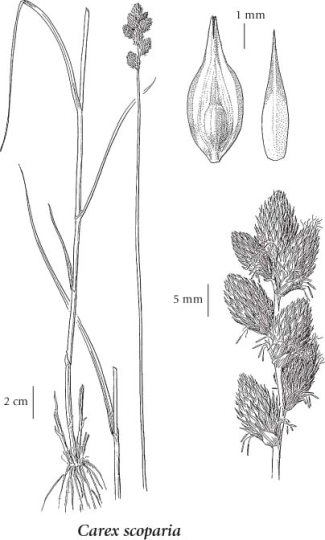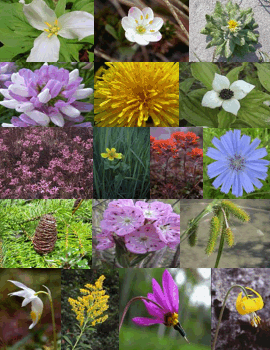pointed broom sedge (broom sedge)
Cyperaceae (Sedge family)
Introduction to Vascular Plants
SUBTAXA PRESENT IN BC click to expand contents
Introduction click to expand contents
Broom sedge is a perennial tufted sedge that is widespread in North America, and is found in most US states and Canadian provinces. In BC, it is found in moist to wet ditches, lakeshores, marshes and meadows in the lowland and montane zones.
In his rare plants of the Fraser Valley article, Lomer (2011) says: "This sedge is most abundant in BC in the Fraser Valley. It grows in wet sites that may dry out by summer's end or remain wet year round. It does well in disturbed man-made habitats such as wet fields, wet hydro line right-of-ways, roadside ditches, and boggy clearings. It can be recognized best by its leafy, clumped habit and compact to somewhat loosely arranged, often nodding, heads of pointed spikelets. It has been recorded from 30 sites in Greater Vancouver, mainly in the Burnaby-Coquitlam-Surrey area (UBC: Lomer 96-190) and is also locally frequent east to Chilliwack". Extracted from Botanical Electronic News #432, January 2011, with permission. A detailed description of this species is given in Flora North America, which recognizes two varieties: var. scoparia and var. tessellata. |
Species Information click to expand contents
General:
Perennial, tufted herb from fibrous roots; stems 15-90 cm tall, exceeding the leaves.
Leaves:
Sheaths tight; blades flat, 1.5-3 mm wide, borne on the lower 1/3 of the stem.
Flowers:
Spikes 4 to 12, aggregated into a 1-5 cm long ellipsoid head, unstalked, with both female and male flowers, the female flowers towards the tips; bracts subtending the spikes sheathless, reduced, the lowermost sometimes awnlike, about 0.5-1.5 cm long.
Fruits:
Perigynia narrowly egg-shaped, 4-6.5 mm long, 1.2-2 mm wide, greenish-white or straw-coloured, more or less flattened, the margins narrowly winged to the bases, the upper 2/3 fringed with teeth, lightly several-nerved on both sides or nerveless below, the beaks obliquely cut on the upper surface, minutely bidentate, 1.2-2 mm long, narrowly margined and toothed below; female scales narrowly elliptical, greenish-white, with translucent margins, shorter and narrower than the perigynia; stigmas 2; achenes lens-shaped, 1.1-1.5 mm long. vol6_4
Illustration click to expand contents

If more than one illustration is available for a species (e.g., separate illustrations were provided for two subspecies) then links to the separate images will be provided below. Note that individual subspecies or varietal illustrations are not always available.
Illustration Source: The Illustrated Flora of British Columbia
USDA Species Characteristics click to expand contents
Flower Colour:
Green
Blooming Period:
Late Spring
Fruit/Seed characteristics:
Colour: Brown
Present over the Summer
Source: The USDA
Ecology click to expand contents
The table below shows the species-specific information calculated from
original data (BEC database) provided by the BC Ministry of Forests and Range.
(Updated August, 2013)
| Site Information |
Value / Class |
||
|
Avg |
Min |
Max |
|
| Elevation
(metres) |
1719 | 405 | 2090 |
| Slope
Gradient (%) |
4 | 0 | 21 |
|
Aspect (degrees) |
275 | 20 | 338 |
| Soil
Moisture Regime (SMR) [0 - very xeric; 4 - mesic; 8 - hydric] |
5 | 2 | 7 |
| Modal
Nutrient Regime
Class |
B | ||
| #
of field plots species was recorded in: |
15 | ||
| Modal
BEC Zone Class |
ESSF | ||
|
All BEC Zones (# of stations/zone) species was recorded in |
ESSF(10), IDF(1), MS(4) | ||
|
Source:
Klinkenberg 2013
|
|||
